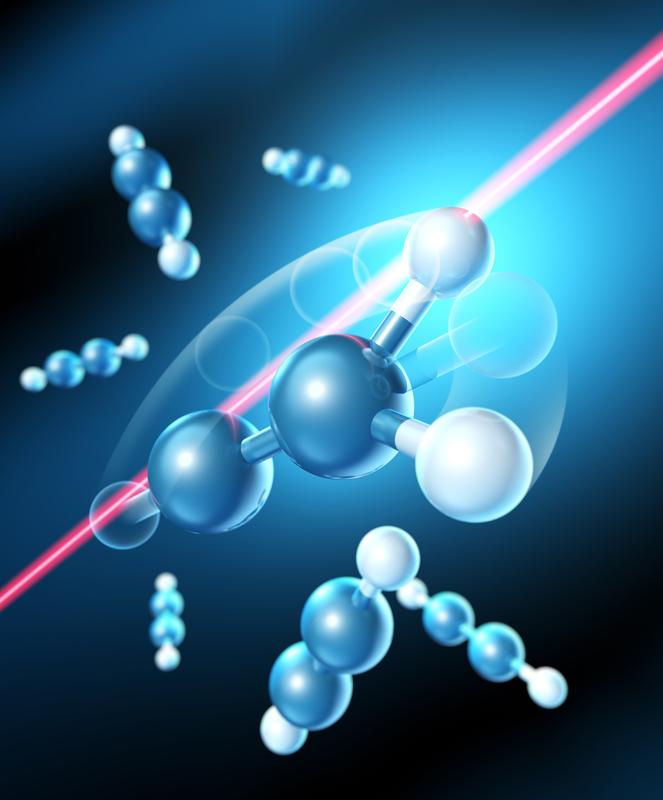Laser pulses: conductors for protons

Laser physicists steer atoms in molecules with light: A laser pulse removed an outer hydrogen atom from one side of a hydrocarbon molecule and directed it to the opposite side, where it rebounded. Image: Alexander Gelin
Light can conduct the play of atoms and molecules in the microcosm. Humans manage to interfere with this play. Researchers from the Laboratory of Attosecond Physics (LAP) of the Max Planck Institute of Quantum Optics (MPQ) and the Ludwig-Maximilians-Universität (LMU) and from the Department of Chemistry at the LMU have now used light to reconfigure hydrocarbons. Using ultrashort laser pulses they removed an outer hydrogen atom from one side of a hydrocarbon molecule and directed it to the opposite side, where it reattached. The method could be used in the future to synthesize new substances by controlling chemical reactions.
Everything in these experiments happens unbelievably fast – within just a few millionths of a billionth of a second. An ultrashort laser pulse hits an acetylene molecule. The symmetric, linear hydrocarbon molecule with one hydrogen atom on each outer side starts to wobble, and is ionized, causing the molecule to become aligned within the laser field. On an extremely short timescale, a hydrogen atom on one side detaches and migrates to the other side, where it rebinds.
The researchers from the Laboratory of Attosecond Physics at MPQ and LMU, and from the Department of Chemistry at LMU, were able to control the directionality of this reaction. The experimental observations and their underlying mechanisms were elucidated by quantum-mechanical simulations performed in Prof. Regina de Vivie-Riedle’s group. Using laser pulses lasting only a few femtoseconds, the physicists influenced the vibrations of the acetylene molecules in such a way that they could selectively remove a particular hydrogen atom from either the left or right side of the molecule.
The hydrogen atom then spontaneously migrated across the molecule to the other side, resulting in the formation and release of the chemical vinylidene. The researchers have also used the technique to reconfigure allene, a larger molecule belonging to the same group of hydrocarbons as acetylene. In doing so, they demonstrated that their method also worked for hydrocarbons with longer chain lengths.
Motions of electrons and atoms are fundamental to chemical processes in nature. With laser technology, researchers are developing ways to influence these motions. “Our experiments have shown that we are not only able to direct electrons in the microcosm, but also hydrogen atoms, which are about 2000-times heavier”, says Prof. Matthias Kling, the leader of the Ultrafast Nanophotonics group at the LAP. “In both cases it is the wave nature of the controlled particles that is responsible for the underlying mechanism“, as Prof. de Vivie-Riedle explains.
The researchers have thus reconfigured matter with the aid of light in their experiment. “We hope that we will be able to take apart various kinds of substances in the future and put them back together at will”, says Kling. Such a light-driven mode of chemical synthesis could help to fabricate new substances in the future. This prospect is particularly appealing in medicine and the design of new drugs. Thorsten Naeser
Media Contact
More Information:
http://www.mpq.mpg.de/All latest news from the category: Physics and Astronomy
This area deals with the fundamental laws and building blocks of nature and how they interact, the properties and the behavior of matter, and research into space and time and their structures.
innovations-report provides in-depth reports and articles on subjects such as astrophysics, laser technologies, nuclear, quantum, particle and solid-state physics, nanotechnologies, planetary research and findings (Mars, Venus) and developments related to the Hubble Telescope.
Newest articles

Silicon Carbide Innovation Alliance to drive industrial-scale semiconductor work
Known for its ability to withstand extreme environments and high voltages, silicon carbide (SiC) is a semiconducting material made up of silicon and carbon atoms arranged into crystals that is…

New SPECT/CT technique shows impressive biomarker identification
…offers increased access for prostate cancer patients. A novel SPECT/CT acquisition method can accurately detect radiopharmaceutical biodistribution in a convenient manner for prostate cancer patients, opening the door for more…

How 3D printers can give robots a soft touch
Soft skin coverings and touch sensors have emerged as a promising feature for robots that are both safer and more intuitive for human interaction, but they are expensive and difficult…





















